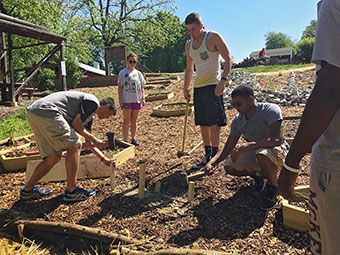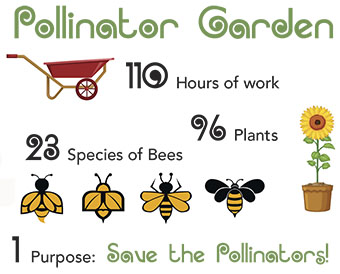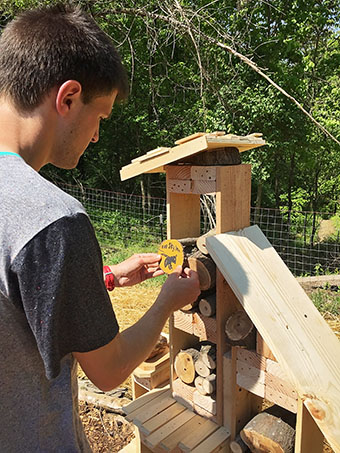Bearcat Beehive Project is an Interdisciplinary Collaboration
by Greg Kassen ’18 Over the past year and a half, a large group of McKendree University students, working
across various disciplines, took part in a project to restore the pollinator plot
at the Willoughby Heritage Farm and Conservation Reserve in Collinsville, Ill. Adopting
the name the “Bearcat Beehive Project,” eight different disciplines had a hand in
the restoration, spanning 10 unique courses and involving 129 students.
Over the past year and a half, a large group of McKendree University students, working
across various disciplines, took part in a project to restore the pollinator plot
at the Willoughby Heritage Farm and Conservation Reserve in Collinsville, Ill. Adopting
the name the “Bearcat Beehive Project,” eight different disciplines had a hand in
the restoration, spanning 10 unique courses and involving 129 students.
“We were extremely pleased with the end result and impressed with the collaborative
efforts of the staff and students,” said Carol Frerker, Willoughby Farm supervisor.
“We were excited to see how everyone pulled it all together as a team utilizing individual
skills, expertise and academic experiences. With the different academic fields working
together, many goals were reached and the ecological impact was that much greater.”
On the farm, the pollinator garden provides three major functions. First, the main
role of the garden is to attract, feed, and provide habitat for the population of
local pollinators. These pollinators mostly include bees; however, butterflies, birds,
and even bats are found to be pollinators in nature. In addition to this function,
the garden acts as a stormwater bioswale to catch and reclaim runoff water from the
farm. Prior to the garden’s installation, the excess stormwater was “causing severe
farmyard erosion,” according to Carol.  Concerning the garden’s third function, Carol describes a space where visitors can
view the plot. Included in this space is a path for observers, with labels along the
way to inform about the various parts of the garden. “The intention is to provide
an exploratory area that will attract and educate visitors about our pollinators,
habitat loss, along with resources on how to make a difference in their own backyard,”
she said. In addition to this, Carol stresses another benefit of the garden: “We will
also simply enjoy its beautiful blooms with each season!”
Concerning the garden’s third function, Carol describes a space where visitors can
view the plot. Included in this space is a path for observers, with labels along the
way to inform about the various parts of the garden. “The intention is to provide
an exploratory area that will attract and educate visitors about our pollinators,
habitat loss, along with resources on how to make a difference in their own backyard,”
she said. In addition to this, Carol stresses another benefit of the garden: “We will
also simply enjoy its beautiful blooms with each season!”
Although much of the planting was done in the spring, planning for the project began
in 2016. Eventually, throughout the semester, an idea was formed and general student
projects were determined. The faculty then took the project to the classroom.
“I visited each class involved in the project and gave an introductory presentation
on pollination, bee diversity, and the importance of pollinators,” said Dr. Michele Schutzenhofer ’03, chair of the Division of Science and Mathematics and the project organizer. “Each
class then brainstormed ideas for a theme, which ended up being the Bearcat Beehive
Project. The theme was chosen because the students said that they were like a hive
since they were all working on separate tasks but also working together with a common
objective.” The disciplines that went on to contribute directly to the Willoughby project included
biology, environmental studies, professional writing and art. Minor roles were given
to courses in education, political science, environmental studies, and health and
wellness. Each discipline was assigned tasks suitable to their field. Students in
the environmental studies’ ENS 490 course, for instance, developed and installed the
garden throughout the semester. Their tasks included selecting the appropriate plants,
laying out the dimensions, and determining the number and size of the plant beds.
Senior Tanner Cicci, who worked with Willoughby as an intern during the spring of 2018, said his main
task “was to pick what plants we wanted to install. I made sure in each individual
flower box there would be something in bloom early, middle, and later in the season
so there would always be something to pollinate. I also had to pick some plants to
go in the swale to help combat the erosion issue Willoughby wanted us to address.”
The disciplines that went on to contribute directly to the Willoughby project included
biology, environmental studies, professional writing and art. Minor roles were given
to courses in education, political science, environmental studies, and health and
wellness. Each discipline was assigned tasks suitable to their field. Students in
the environmental studies’ ENS 490 course, for instance, developed and installed the
garden throughout the semester. Their tasks included selecting the appropriate plants,
laying out the dimensions, and determining the number and size of the plant beds.
Senior Tanner Cicci, who worked with Willoughby as an intern during the spring of 2018, said his main
task “was to pick what plants we wanted to install. I made sure in each individual
flower box there would be something in bloom early, middle, and later in the season
so there would always be something to pollinate. I also had to pick some plants to
go in the swale to help combat the erosion issue Willoughby wanted us to address.”
The informative signs lining the walkway of the garden were created through collaboration
as well. The material used for the signs was developed by the BIO 320 Conservation
Biology course, text that appeared on the signs was composed by professional writing
students, and artwork that adorned the signs was created by the art department. During
his internship, Tanner installed the signs on site.
“This project definitely provided many learning opportunities for me by providing
various challenges,” said Emily Stanowski ’18, a marketing major and professional writing student who helped to create the signs,
“but it was definitely worth it to be able to see my work come to life.”
The art department, in addition to decorating the signs, created two “bee hotels,”
intended to house the pollinators of the garden.
“They truly made an ecological and professional impact on Willoughby Farm and the
future of our pollinators,” Carol said in regards to the students. “And, they simply
made a positive difference in our community and region.”

